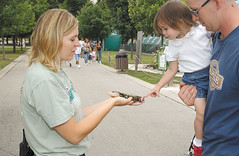Volunteer coordination is hard work, and there are a lot of misconceptions about what the role entails (and how to be successful along the way). We’re here today to de-bunk some of the most common myths we hear about volunteer management.
- You’re on call, 24-7. If you’re passionate about your job, managing volunteers could turn into an all-day, every-day gig. But with established communication protocols and an active team, you can (and should!) unplug.
- You can’t solicit volunteers for donations. Many volunteers see their time as their primary contribution to an organization, but if there are costs associated with onboarding (background checks, etc.) asking them to cover those fees is a good path into the donor pipeline.
- Volunteer trainings need to involve slides and manuals. Sure, you should cover compliance and protocols in an onboarding, but bring the mission to life with role-playing, behind-the-scenes tours or other activities that engage and inspire volunteers.
- You should be happy with whoever you get. That old “beggars can’t be choosers” philosophy could really disrupt your organization. Screening volunteers is critical. They should be a right match for the organization, and placed in a role that maximizes their skills.
- There’s no professional development for volunteer managers. So many people fall into this line of work. Seek out a support system of other volunteer managers who can share best practices through your local United Way, nonprofit professionals network or online forums. They can also recommend conferences and webinars to grow your skills.
- Volunteer programs are free. While a volunteer program can bring great value to your organization, they’re like a garden that needs attention and investment to yield the best results. Don’t forget to build recognition materials, management software and other supplies into your budget.
- Your organization should jump on every Day of Service opportunity or group volunteer request. Saying ‘no’ to someone (or lots of someones) who want to contribute to your organization can seem crazy. But if the activity is out of scope for your organization, a ‘yes’ can lead to confusion and cause more harm than good.
- You’re the only one recruiting volunteers for your cause. Partnerships – with corporations, colleges and universities and other civic organizations – can create productive volunteer pipelines.
- Liability and insurance isn’t your territory. Make sure you are working closely with your organizations’ compliance arm to ensure both volunteers and the organization are not putting each other at risk.
- Measuring volunteer impact is impossible. With proper tracking of volunteer hours and assignments, your organization can put a relative dollar value on volunteer power. And by collecting stories of volunteer initiatives and outcomes, your leveraging powerful anecdotes to support your cause.






 Let’s keep talking about brand ambassadors! In our first post on growing brand ambassadors, we talked about putting together intentional steps to help move your volunteers from people who work with you occasionally into people who are fired up about what you do and talk about you even when they’re not volunteering. (If you missed the first post, go ahead and catch up! We’ll be here when you’re done.)
Let’s keep talking about brand ambassadors! In our first post on growing brand ambassadors, we talked about putting together intentional steps to help move your volunteers from people who work with you occasionally into people who are fired up about what you do and talk about you even when they’re not volunteering. (If you missed the first post, go ahead and catch up! We’ll be here when you’re done.)

 Before we get started, let me be honest: I’m not great at asking for money. Talking about money makes me uncomfortable. Asking for money makes me uncomfortable. But at the end of the day, we in the nonprofit and event management business can’t avoid it. Procuring and developing sponsorship relationships is essential to success.
Before we get started, let me be honest: I’m not great at asking for money. Talking about money makes me uncomfortable. Asking for money makes me uncomfortable. But at the end of the day, we in the nonprofit and event management business can’t avoid it. Procuring and developing sponsorship relationships is essential to success. Find Sponsors that Fit.
Find Sponsors that Fit. helping to coordinate. Visions can be vague, but putting in the time to create a well-defined idea will take you a long way. In order to have a successful event you need to know what outcome you want and how to attain it. We’ve rounded up some simple steps to help you develop a precise plan for your event so you can get your whole team on board.
helping to coordinate. Visions can be vague, but putting in the time to create a well-defined idea will take you a long way. In order to have a successful event you need to know what outcome you want and how to attain it. We’ve rounded up some simple steps to help you develop a precise plan for your event so you can get your whole team on board. Step 3: Communicate
Step 3: Communicate